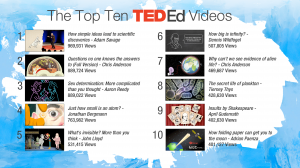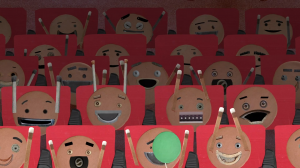
Behind the scenes with CERN physicists

Recently, the physicists at CERN and the animators at TED-Ed teamed up to combine what they do best (complex particle physics) with what we do best (animations that illuminate tough concepts). The results were broadcast on Friday at TEDxCERN, between incredible talks ranging from women in science to consciousness to grid computing, attendees watched animations on everything from the origins of the universe to the mystery of anti-matter.
We caught up with some of the physicists behind these lessons to ask them what it was like to work with animators and see their lesson on the big screen.
1. What was your favorite part of working with an animator?
Tom Whyntie (The beginning of the universe, for beginners): I loved seeing what they did with the words, and with the story. It’s not often you get to work with a team who intrinsically “get” what you’re doing, and everyone at Hornet Inc. managed to take what I’d written and bring it to life in ways I hadn’t even imagined. They took the technical notes on board brilliantly, too – even down to the quarks having curly gluon-like moustaches – so there are plenty of ”Easter Eggs” in there for the experts. An utter joy to be a part of.
Steve Goldfarb (The basics of the boson): Jeanette was fantastic. I was caught by surprise at first by the world she created, but quickly appreciated the effort to humanize (worm-ize?) the characters. Even our boson was personable. Jeanette was also very quick and effective at iterating with us for the minor changes and corrections we offered. It was a fantastic experience and I am ready to do it again tomorrow!
Dave Barney (The basics of the boson): Totally agree with Steve. The iteration with the animator was the part I was fearing most, believing it would be a great deal of work to transform our script into something tangible. It was not; it was easy. Jeanette was fantastic and we were really happy with the result.
Tim Smith (Exploration on the Big Data frontier): The ease and speed with which the animators could take vague ideas, extract the essence and translate that into something appealing.
Rolf Landua (What happened to antimatter?): The favourite part of working with “my” really outstanding animator was to see that he could understand and translate my – rather abstract – concepts into clear, concise, and visually attractive images. Franz represented our target audience perfectly, by being inquisitive, interested, and ready to dive into new concepts. Explaining the story to him made me confident that the final animation would be successful .
James Gillies (Dark matter: The matter we can’t see): I loved seeing how the ideas came to life through the different develpment stages of the animation.
2. What was it like seeing your animation for the first time? Especially those of you who were, yourselves, characters in the animations?
Tom Whyntie: It’s not often you get to see yourself as a galaxy, with your spiral arms waving around. But I think CBS News were (perhaps surprisingly) the most accurate: “British voiced blob” is pretty much hits the nail on the head.
Steve Goldfarb: I’ve always felt like a worm, especially after a few shots of tequila. However, I am not sure I’ll ever get used to having Dave’s voice. (TED-Ed note: Steve and Dave actually switched roles for the recording of the lesson, with Steve reading Dave’s part, and vice versa) Still, it was an eye-opening experience. Having a professional animator bring her sense of artistry and imagination to the project makes all the difference in the world. It turned a rather dry dialogue into an adventure.
Tim Smith: It was fun, and I had hair again. I hadn’t imagined seeing the narrator, but I immediately took to the idea when I saw the amusing way the animators had depicted me.
3. Do you think that there are benefits to teaching physics through animations?
James Gillies: An important part of my work is to engage and enthuse people about physics, and hopefully encourage them to dig deeper. The TED-Ed format of animations linked to additional material and further resources is brilliant for this.
Steve Goldfarb: Absolutely! I think there is a process to communicating science: As with all topics, it starts with enticing the audience with an interesting setting and story. One then needs to carefully reel in the line (funny analogy for someone who plays a worm), educating them on the topic while maintaining the excitement and developing their interest to learn more. These animations, closely coupled with background material that is easy to access, makes for a great combination.
David Barney: As Tim said, many of the concepts we deal with are abstract in the extreme. And we have, for a few years, been trying to conceive and produce animations. But with scant resources on our side it has been very difficult for much to come to fruition. This series of animations hopefully opens the doorway to others.
Rolf Landua: Absolutely and positively: yes. Many concepts in physics are very abstract and not (or not directly) accessible to our senses. Animations allow to show what is beyond our perception. This is particularly true when we are trying to show the ‘extremes’ of physics: the very small or very large dimensions of the Universe, the very fast or the extremely slow time scales. We are presently investing a large effort in producing a lot more animations about the physics and technology at CERN, and we are confident that it will help us in our education and outreach efforts.
4. What was the hardest part of translating your ideas into a script and then a visual final product?
Tom Whyntie: Fitting everything in to three minutes! It’s quite literally the biggest topic there is, so we just had to leave out some great science (and history of science, for that matter… but that’s another story). But I was lucky enough to take part in a competition that trained me up to do just that – FameLab, run by the UK’s Cheltenham Science Festival. The training we received in summarising fascinating science in a story-driven way has stuck with me since. In 2009, I spoke for three minutes about how the LHC finding nothing would be the best possible result - fortunately, I’ve got a chance at this year’s festival to provide bit of a Higgs-flavoured update!
Tim Smith: The principal difficulty in making the script was to make it concise whilst still accurate and conveying sufficient information. And for the visual product it was balancing the artistic licence, to attract and entertain, against the true representation, for instance of scale or to avoid stereotypes.
Rolf Landua: The hardest part was writing the script in a way that it reflected the scientific content correctly but would still be “translatable” and comprehensible to non-specialists.
In the end, our TED-ED animators had a great time working with these stellar physicists to create Lessons that are both accurate and engaging. Learning and explaining these complex topics under the guidance of world class physicists has certainly expanded the minds of everyone here at TED-Ed, and we hope that it’s expanded yours too.




Reblogged this on Astronovae.
magnificent publish, very informative. I’m wondering why the other specialists of this sector don’t realize this.
You should continue your writing. I am confident, you’ve a huge readers’ base already!